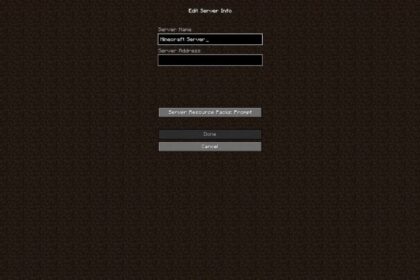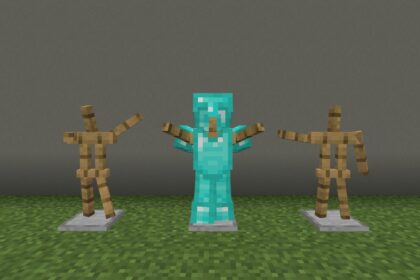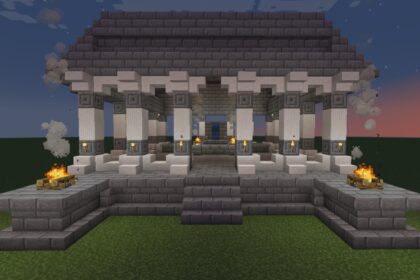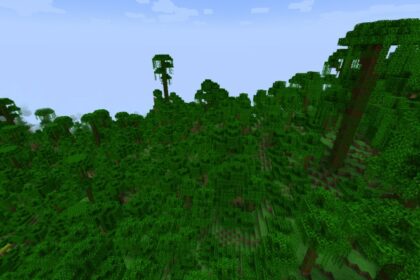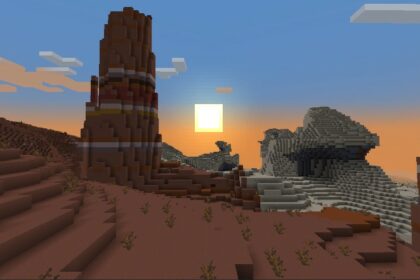The vast world of Minecraft carries massive content regarding resources, survivalism, crafting system, exploration, combat, lore, level, and many more.
Still, one of the most highlighted features in Minecraft is its thorough connection between resources, crafting, and building.
For instance, to build a fancy granite staircase you’ll need to mine some ores, process them, craft the stairs, and place it.
The massive amount of crafting and building possibilities may be intimidating to some.
Yet, even if you choose to play more modestly and rely only on the essential crafting, you’ll need to expertise a bit on the game’s resources.
Ores are exceptionally vital to the gameplay among the vast list of resources we can find while venturing anywhere in Minecraft. Therefore, experiencing yourself in the “mining” segment of the game will be highly fruitful.
So, let’s discuss the importance and vastness of minerals in the game and do our own Minecraft ore levels guide.
Essential Ores
During the early game, it’s vital to know some primary ores to facilitate your gameplay and allow you to progress further. Besides, even on your first in-game day you’ll need to have tools that are at least one level above wooden instruments.
It’s essential to understand that even though we’ve discussed bronze ore before, the mineral isn’t a feature in vanilla Minecraft.
Cobblestone
The most basic mineral you’ll need is cobblestone, which will require any pickaxe to be attainable.
Although pretty low-level, this resource is the bridge to the mid-game since it serves to craft the first resilient tools and weapons you’ll require.

Additionally, stone allows for creating different high-utility furniture, such as furnaces. Besides, they’re your only ticket to gather iron organically, which is the next mineral you’ll need to step up from the early game.
Finally, you can find stone on any Y level on Minecraft, from a cave’s entrance to its deep lava core.
Coal
Coal is vital during the early game. As a resource, it will assist in your survival by facilitating your base to grow, providing you with experience and serving utility tools.
The primary use of coal is for fuel since the heat it creates lasts longer than wood.
Therefore, to advance quickly and process enough ores, building blocks, and food, make sure to gather this resource constantly.

Additionally, coal provides one of the most necessary items for beginners: torches.
Lighting in the game is vital for exploration and even spawn control since enemies usually don’t appear close to light sources at night.
Finding coal is exceptionally quick since it’s abundant in the entire 0 to 320 range. Still, you can also find it in chests in villages, shipwrecks, and dungeons, especially abandoned mines.
Iron
Iron is the mineral you’ll likely use the most during your entire gameplay.
The resource will be your transportation to the late-game status since it’ll assist you in the crafting of highly resilient tools, buildings, mechanisms, and combat items.
Having iron is vital to gathering top-level minerals such as diamonds. So, to successfully develop into the plot, get access to the nether, and even farm combat experience, always mine iron. The sooner you get this resource, the better.

Furthermore, the tools you can make with iron last way longer than the stone ones that sit at a level below. Additionally, they act considerably faster, making mining, farming, growing, lumbering, and attacking highly efficient.
An extra feature that iron introduces the player to is armor. When gathering this resource for the first time, you’ll have the alternative of crafting armor such as helmets, plates, legs, gloves, and shields.
So, iron is the actual leap into the game’s real combat since it allows the player to go full-set into dungeons and enemy spawns.
Moreover, iron bars introduces the player to different high-utility tools, such as:
- Shears
- Anvil
- Blast Furnace
- Rails
- Bucket
- Cauldron
- Compass
- Flint and Steel
- Crossbow
- Chain
Finding iron ore isn’t hard and you’ll be able to mine it using a stone pickaxe. The most common Y levels you’ll find this ore sits between 128 to 320, with 255 having a higher chance of containing the resource.
Additionally, you might find iron bars at village chests on the blacksmith house, shipwrecks, and dungeons.
Diamond
The most iconic mineral in Minecraft, the diamond is undoubtedly among the most challenging items to acquire. But, of course, the resource is also on the top list of vigorous elements, providing the best tools, weapons, and armor.
Having diamonds is necessary to brace Minecraft’s nether and go further into the game’s lore. For instance, the mineral provides a mighty armor that can last significantly longer than iron, which sits at a level below.

Additionally, a player won’t access the netherworld without a diamond pickaxe since the instrument is the only one powerful enough to gather obsidian during the mid-game.
Of course, a netherite pickaxe is an alternative, but it’s a late-game resource.
Moreover, diamond tools, such as pickaxes, axes, and shovels have a significantly fast action and can gather resources exceptionally quickly.
Apart from having an essential role in crafting high-durability instruments, the diamond is also vital in making exclusive tools, improving the gameplay greatly. For example, if you aim to spend experience levels on enchantments, you’ll need to craft the enchantment table.
Since the enchantment table requires two units of diamond and a diamond pickaxe to gather obsidian, you’ll need to pursue this rare mineral.
Finding a diamond is pretty challenging since it’s a scarce mineral. Nevertheless, this ore can be anywhere between -64 to 16 layer level. Yet, they show up on the -59 level more consistently.
Still, finding diamonds in shipwrecks, dungeons, and abandoned mines is fairly typical.
Diverse Ores
The minerals mentioned above are vital during the initial stages of your gameplay and without them you likely won’t progress to the late game. Various other minerals also create handy tools but aren’t strictly essential.
Let’s discuss other ores in Minecraft, which can be highly adequate for cosmetic endeavors, crafting a few valuable tools, and progressing in the game.
Copper
Copper is somewhat abundant in Minecraft. This resource provides an alternatively cheaper armor, weapon, or tool in many survival games. However, in Minecraft, its usage is pretty limited.
Differently from most games, copper in Minecraft only results in three items: Block of copper, lightning rod, and spyglass. Although they can be pretty handy, they’re not precisely essential assets to have.

Finding copper is not hard since the mineral appears at the -16 to 112 layers quite abundantly.
In pitch-black caverns, copper might resemble iron. So, if you’re in fear of tricking yourself to gather distinct blocks, change Minecraft’s gamma.
Gold
Although gold can be a life-saver in the initial stages of the game, chances are you’ll resort to iron as soon as you can. Yes, the mineral can craft armor, weapons, and tools.
However, they’re not as resilient or reliable as iron alternatives.
Nevertheless, to reach top-tier materials, you’ll need gold. So, even though the material is not essential for surviving and evolving through the beginning gameplay, it’s necessary for the late game.
What makes gold a bit less essential is its lower chances of appearing during mining activities.
On the other hand, iron, a more robust mineral, appears more consistently. But, of course, gold still makes handy exclusive items, apart from its solid cosmetic vibe.

In terms of utility, the most crucial role of gold is its function at creating netherite ingots. So, by combining four gold bars with four netherite scraps, one will get the most powerful resource in the game, the netherite ingot.
Additionally, gold can also craft powered rails, complementing various farming mechanisms. Yet, having four gold bars and a unit of Redstone dust allows you to get a clock, which comes in handy.
Finding gold is challenging; it appears at the -64 to 256 and is more consistent in the badlands biome. Additionally, they can commonly appear in treasure chests inside shipwrecks and dungeons.
Still, to gather it, you’ll need an iron pickaxe or superior.
Lapis Lazuli
This somewhat uncommon-to-find mineral is a highly valued cosmetic resource, mainly handy to serve as blue paint and enchanting.
Other than enchanting lapis lazuli doesn’t have any real utility. Nevertheless, if you combine it with beds, carpets, and wool, you’ll get the item to feature a blue color.

A unique resource to find, lapis lazuli appears between the -64 to 320 layer, showing more consistently at the 15 and 232 areas. Still, to gather it, you’ll need a stone pickaxe or superior. Additionally, lapis lazuli also appears in the overworld as blobs.
Emerald
Emeralds are somewhat meaningful to gather since they serve as the game’s currency.
In addition, every Minecraft village has a market system, which gravitates towards emeralds. So, this resource can be a considerable facilitator if you stumble upon a village.
However, emeralds bring little to the table apart from serving as currency since they’re not helpful when crafting anything. Still, creating an emerald block can be pretty cosmetically attractive since it portrays luxury.

Finding emeralds can be pretty tricky since the ore only appears in the mountains and windswept hills biomes. The “Y” levels you’ll find this ore are between -16 to 320. However, it’s easier to find it around the 236 level.
Still, to gather it, you’ll need an iron grade pickaxe or superior.
Redstone
Even though many players can go through entire gameplays without using Redstone, the mineral is a highly complex strategy resource.
Redstone’s most noticeable use is transmitting power through circuits, allowing the construction of unique farming and automatic machinery. Additionally, players who enjoy using alchemy will undoubtedly need Redstone to craft potions.
Redstone is active in the construction of powered systems in Minecraft, but it also takes part in crafting some utility tools. For instance, compasses and clocks require one unit of Redstone dust.
Moreover, the resource is also vital to produce defense mechanisms such as dispensers, observers, and droppers.
Finally, it’s pretty impossible to mention all possibilities that Redstone allows for the player who knows how to use it, for they are many.
Finding Redstone ore is somewhat uncommon. However, they tend to come in numerous units when you find them. The resource appears in the -64 to 16 levels, appearing more consistently in the -59 layer.

Still, to gather it, you’ll need an iron grade pickaxe or superior.

